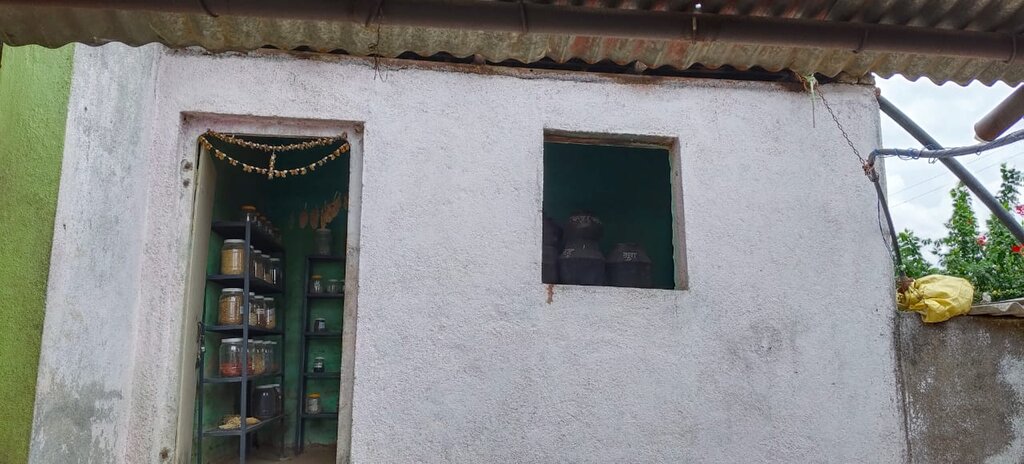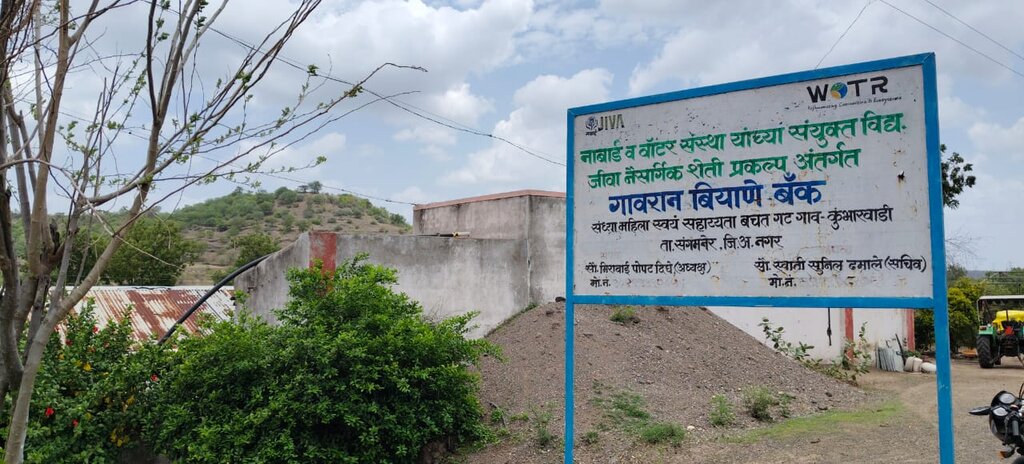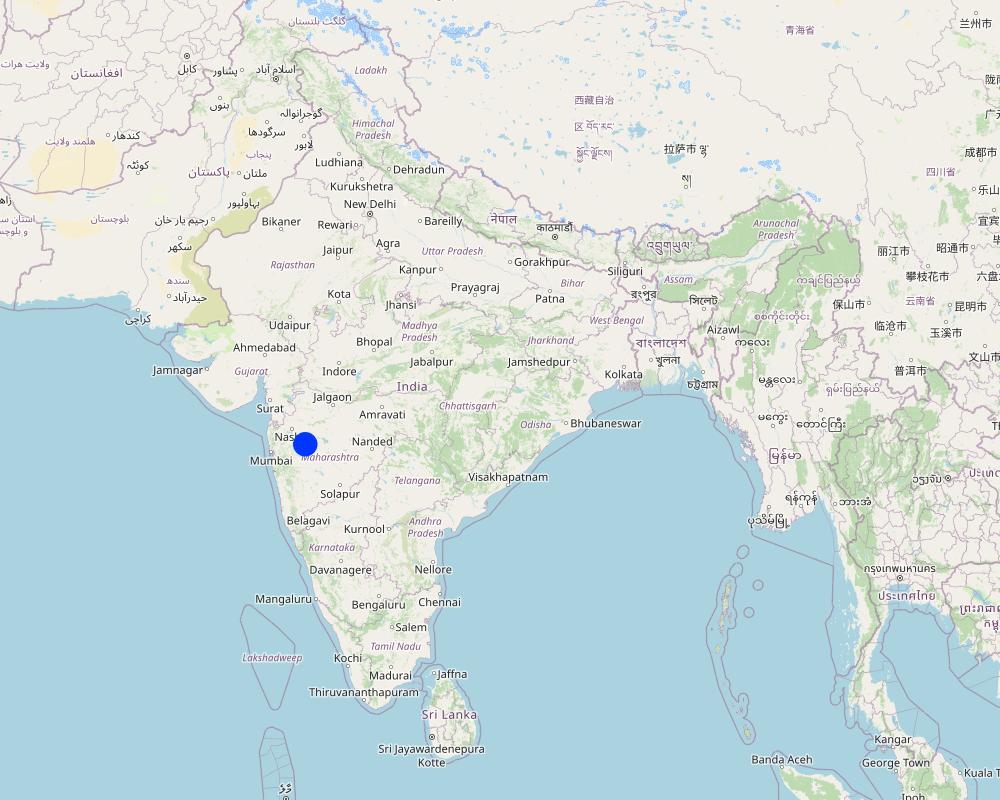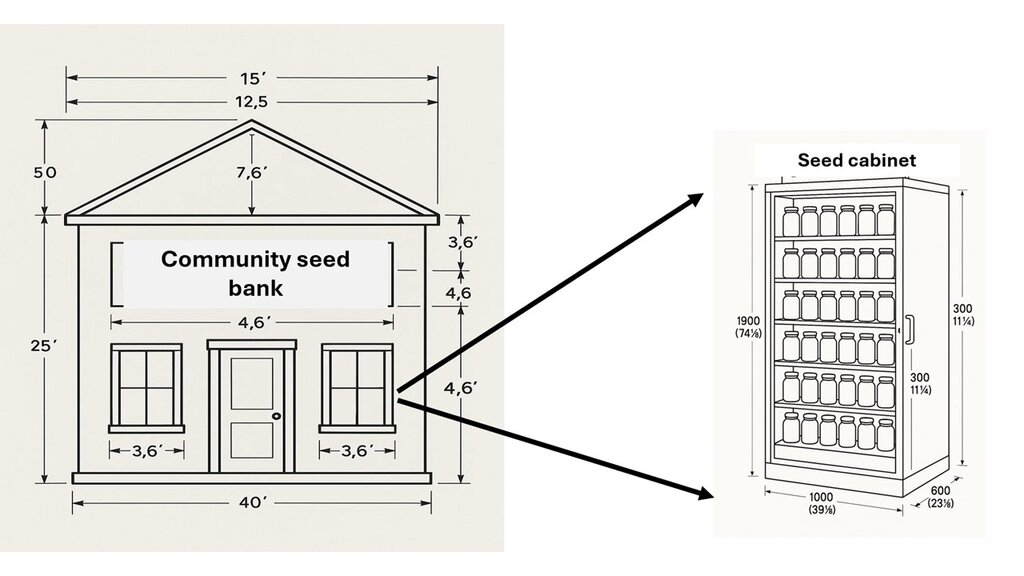Community seed banks [Índia]
- Criação:
- Atualização:
- Compilador/a: Pratik Ramteke
- Editor: –
- Revisores: Rima Mekdaschi Studer, William Critchley
Seed banks
technologies_7552 - Índia
Veja as seções
Expandir tudo Recolher tudo1. Informação geral
1.2 Detalhes do contato das pessoas capacitadas e instituições envolvidas na avaliação e documentação da tecnologia
Nome do projeto que facilitou a documentação/avaliação da Tecnologia (se relevante)
Enabling Agro-ecological Transitions in Rainfed Landscapes (JIVA)1.3 Condições em relação ao uso da informação documentada através de WOCAT
O/a compilador/a e a(s) pessoa(s) capacitada(s) aceitam as condições relativas ao uso de dados documentados através da WOCAT:
Sim
1.4 Declaração de sustentabilidade da tecnologia descrita
A tecnologia descrita aqui é problemática em relação a degradação da terra de forma que não pode ser declarada uma tecnologia de gestão sustentável de terra?
Não
2. Descrição da tecnologia de GST
2.1 Descrição curta da tecnologia
Definição da tecnologia:
A community-based seed bank system is a locally managed initiative where farmers and community members collect, store, and share seeds to ensure germplasm and food security, preserve crop diversity, and support sustainable agriculture. These banks are governed by community rules.
2.2 Descrição detalhada da tecnologia
Descrição:
Community Seed Banks (CSBs) are locally governed systems designed to enhance food and seed security, promote sustainable, climate-resilient farming as well as conserving agrobiodiversity. CSBs bridge traditional agricultural knowledge with evolving best practices, ensuring the continuity of seed diversity adapted to local conditions.
A key function of CSBs is seed preservation and exchange. They provide for the collection of seeds from farmers, prioritizing varieties that have demonstrated superior local adaptation. Seeds are carefully cleaned, dried, and tested for viability before being stored—typically in clay pots in a simple building. The preserved seeds can be used in future planting seasons or distributed during droughts, floods, or pest outbreaks, thereby ensuring timely access to reliable seed material.
A CBS conserves and manages a diverse range of locally important crops including both cereals (sorghum and maize) and legumes (black grams, chickpeas, cowpeas, green grams, green peas, groundnuts, horse grams, red grams, and soybeans). Several traditional and improved cultivars of each crop are stored, selected on their performance under local conditions, including drought tolerance, pest and disease resistance, yield stability, and cultural preference. The quantity of seeds stored per cultivar ranges from 500 grams to 100 kilograms, depending on availability and community demand. For seed protection, both indigenous practices and materials such as wood ash, neem leaves (Azadirachta indica), and chili extract (Capsicum frutescens) are used to prevent pest infestation during storage, minimizing reliance on commercial pesticides.
Management of CSBs is local and participatory. They are generally governed by elected community committees that set the rules for deposit, withdrawal and replenishment. This governance structure ensures that the seed bank reflects the specific needs and knowledge systems of the community. Community engagement is not only vital for operational success but also fosters a sense of ownership and collective responsibility.
CSBs play a multifaceted role. They contribute to agrobiodiversity conservation by safeguarding traditional and wild crop varieties, which are invaluable for future breeding programs. Furthermore, they ensure that farmers can access seeds during critical periods. Additionally, CSBs promote sustainable agricultural practices by reducing reliance on commercial seed systems. They also help to document and share traditional farming knowledge.
The operational structure of a CSB begins with community mobilization and capacity-building focused on seed selection, handling, and storage. Infrastructure requirements are modest. Maintenance involves tasks such as viability testing to ensure the germination potential of stored seeds.
CSBs enhance the resilience of agricultural systems by enabling communities to recover swiftly from crop failures: they also reduce input costs. Furthermore, CSBs empower communities—particularly smallholder farmers and women. Moreover, these banks store vital genetic material for future research.
From a community perspective, the benefits are substantial. However, challenges remain. High initial investments in infrastructure and training are required, and ongoing success depends on strong community engagement and diligent record-keeping. Nevertheless, by preserving the genetic heritage of crops and empowering local communities, CSBs reduce contribute to food sovereignty
2.3 Fotos da tecnologia
2.5 País/região/locais onde a tecnologia foi aplicada e que estão cobertos nesta avaliação
País:
Índia
Região/Estado/Província:
Maharashtra
Especificação adicional de localização:
Kumbharwadi village, Tal. Sangamner, Dist: Ahilyanagar
Especifique a difusão da tecnologia:
- Aplicado em pontos específicos/concentrado numa pequena área
O(s) local(is) tecnológico(s) está(ão) localizado(s) em uma área permanentemente protegida?
Não
Comentários:
This documentation covers a single CSB located at Kumbharwadi village.
Map
×2.6 Data da implementação
Indique o ano de implementação:
2024
2.7 Introdução da tecnologia
Especifique como a tecnologia foi introduzida:
- através de projetos/intervenções externas
Comentários (tipos de projeto, etc.):
JIVA – An Agroecology-Based Programme, Implementing Agency: National Bank for Agriculture and Rural Development (NABARD)
3. Classificação da tecnologia de GST
3.1 Principal/principais finalidade(s) da tecnologia
- Melhora a produção
- Preservar/melhorar a biodiversidade
- Adaptar a mudanças climáticas/extremos e seus impactos
- Criar impacto econômico benéfico
- Cria impacto social benéfico
3.2 Tipo(s) atualizado(s) de uso da terra onde a tecnologia foi aplicada
Uso do solo misturado dentro da mesma unidade de terra:
Sim
Especificar o uso misto da terra (culturas/ pastoreio/ árvores):
- Agrofloresta

Terra de cultivo
- Cultura anual
- Cultura de árvores e arbustos
Cultivo anual - Especificar culturas:
- cereais - milho
- cereais - painço
- culturas forrageiras - alfalfa
- legumes e leguminosas - soja
- legumes - raízes (cenouras, cebolas, beterraba, outros)
Cultivo de árvores e arbustos - Especificar culturas:
- manga, mangostão, goiaba
- Custard Apple
Número de estações de cultivo por ano:
- 2
O cultivo entre culturas é praticado?
Sim
Em caso afirmativo, especifique quais são as culturas intercultivadas:
Red gram, black gram and green gram intercropped with pearl millet or soybean;
cowpea, horse gram intercropped with groundnuts
O rodízio de culturas é praticado?
Sim
Caso afirmativo, especifique:
Cereals-pulses

Floresta/bosques
- Plantação de árvores, reflorestamento

Vias navegáveis, corpo d'água, zonas úmidas
- Lagos, represas
Principais produtos/serviços:
Irrigation and domestic use
3.3 O uso do solo mudou devido à implementação da Tecnologia?
O uso do solo mudou devido à implementação da Tecnologia?
- Não (Continuar com a pergunta 3.4)
3.4 Abastecimento de água
Abastecimento de água para a terra na qual a tecnologia é aplicada:
- Misto de precipitação natural-irrigado
Comentários:
Irrigation source: well, farm pond
3.5 Grupo de GST ao qual pertence a tecnologia
- Gestão integrada de pragas e doenças (inclusive agricultura orgânica)
- variedades vegetal/raças de animais melhoradas
- Redução de riscos de desastre baseada no ecossitema
3.6 Medidas de GST contendo a tecnologia

Medidas estruturais
- S9: Abrigo para plantas e animais
- S11: Outros
Comentários:
The CSB includes permanent infrastructure (e.g., a small house or storage facility built with community effort) for the secure preservation and storage of seeds.
3.7 Principais tipos de degradação da terra abordados pela tecnologia

Deteriorização química do solo
- Cn: declínio de fertilidade e teor reduzido de matéria orgânica (não causado pela erosão)

Degradação biológica
- Bh: perda dos habitats
- Bs: Qualidade e composição de espécies/declínio de diversidade
- Bp: aumento de pragas/doenças, perda de predadores

Degradação da água
- Hg: mudança no lençol freático/aquífero

Outro
Especifique:
Agrobiodiversity loss and climate-related seed insecurity
→ The CSB addresses the degradation of crop genetic resources, which is a foundational pillar of sustainable land management.
3.8 Redução, prevenção ou recuperação da degradação do solo
Especifique o objetivo da tecnologia em relação a degradação da terra:
- Prevenir degradação do solo
- Reduzir a degradação do solo
Comentários:
→ By conserving traditional seed varieties that require fewer external inputs, the CSB helps prevent soil and biodiversity degradation.
→ Promoting resilient, diverse, and low-input seed systems contributes to reducing ongoing degradation (e.g., fertility decline, loss of biodiversity).
4. Especificações técnicas, implementação de atividades, entradas e custos
4.1 Desenho técnico da tecnologia
Especificações técnicas (relacionada ao desenho técnico):
The structure shown is for reference. Any enclosed room with suitable ventilation and storage conditions can serve as a seed bank.
More detail of storage pots and a brief description:
The seed bank utilizes traditional earthen pots (locally known as matka or bharani) and airtight glass/plastic jars as primary storage containers. The large clay pots are arranged on raised platforms and shelves to avoid moisture contact from the floor. These pots are labelled in local script (Marathi), clearly indicating the crop name (e.g., sorghum, cowpea, maize, etc.) and variety stored. Each pot is covered with cloth and tied securely, ensuring ventilation while preventing pest entry.
These earthen pots are ideal for seed storage in rural, low-cost setups as they:
•Maintain cool internal temperatures, reducing seed deterioration.
•Are naturally aerated, preventing moisture buildup.
•Can be easily sealed using cloth or organic sealants like cow dung or ash to control pests.
The glass and plastic jars used on metal racks are suited for small seed quantities, mainly for short-term storage or display during training sessions and exchanges. Each jar is labelled with variety and harvest details, supporting proper documentation and traceability.
Autor:
Pratik Ramteke
Data:
12/05/2025
4.2 Informação geral em relação ao cálculo de entradas e custos
Especifique como custos e entradas foram calculados:
- Por unidade de tecnologia
Especifique a unidade:
1
Especificar as dimensões da unidade (se for relevante):
A typical unit consists of a single room structure (approx. 10 x 10 feet) equipped with traditional clay pots (15–25 units) and glass or plastic jars (20–50 units) used for storing seeds. The average storage capacity of one unit is approximately 200–500 kg, depending on the number of crop varieties and seasonal seed availability.
Outro/moeda nacional (especifique):
Indian Rupees
Se for relevante, indique a taxa de câmbio do USD para moeda local (por exemplo, 1 USD = 79,9 Real): 1 USD =:
84,0
Indique a média salarial da mão-de-obra contratada por dia:
500
4.3 Atividades de implantação
| Atividade | Periodicidade (estação do ano) | |
|---|---|---|
| 1. | Site selection for seed bank structure (within SHG household/community building) | February–March (before Rabi harvest) |
| 2. | Construction/preparation of storage structure (room cleaning, plastering, shelf fixing) | March–April |
| 3. | Procurement of local seed varieties | April–May (before monsoon/ Kharif sowing) |
| 4. | Procurement and setup of seed storage containers (clay pots, glass jars, bags) | April–May (before onset of rain) |
| 5. | Installation of racks, shelves, moisture absorbers | May |
| 6. | Labelling of containers and organization of storage system | May–June |
| 7. | Setup of documentation tools (register books, seed stock cards) | June (onset of monsoon) |
4.4 Custos e entradas necessárias para a implantação
| Especifique a entrada | Unidade | Quantidade | Custos por unidade | Custos totais por entrada | % dos custos arcados pelos usuários da terra | |
|---|---|---|---|---|---|---|
| Mão-de-obra | Trainer Fees | person days | 1,0 | 2500,0 | 2500,0 | |
| Equipamento | Furniture / Rack | pieces | 10,0 | 800,0 | 8000,0 | |
| Equipamento | Seed Store Jar and Bag | pieces | 200,0 | 20,0 | 4000,0 | |
| Material vegetal | Purchase of seed | kg | 50,0 | 450,0 | 22500,0 | |
| Outros | Training food charges, materials, boards, exposure visit charges, register book, charts, etc. | 1,0 | 8100,0 | 8100,0 | ||
| Custos totais para a implantação da tecnologia | 45100,0 | |||||
| Custos totais para o estabelecimento da Tecnologia em USD | 536,9 | |||||
Se o usuário da terra arca com menos que 100% dos custos, indique quem cobre os custos remanescentes:
Project
Comentários:
Around 90-95% of costs were supported by the implementing project JIVA (NABARD), while the remaining was contributed by the community through local materials and voluntary labour
4.5 Atividades recorrentes/manutenção
| Atividade | Periodicidade/frequência | |
|---|---|---|
| 1. | Labour (e.g., supervision, helpers) | each cropping season |
| 2. | Replacement of broken jars | as per need |
| 3. | Labelling changes (charts, tags) | annually |
| 4. | Equipment maintenance and repair | as per need |
4.6 Custos e entradas necessárias pata a manutenção/atividades recorrentes (por ano)
| Especifique a entrada | Unidade | Quantidade | Custos por unidade | Custos totais por entrada | % dos custos arcados pelos usuários da terra | |
|---|---|---|---|---|---|---|
| Mão-de-obra | Labour (e.g., supervision, helpers) | man-days | 10,0 | 300,0 | 3000,0 | |
| Equipamento | Replacement of broken jars | pieces | 10,0 | 20,0 | 200,0 | |
| Equipamento | Labelling changes (charts, tags) | 5,0 | 300,0 | 1500,0 | ||
| Equipamento | Equipment maintenance and repair | 1,0 | 2000,0 | 2000,0 | ||
| Material vegetal | 1,0 | |||||
| Custos totais para a manutenção da tecnologia | 6700,0 | |||||
| Custos totais de manutenção da Tecnologia em USD | 79,76 | |||||
Se o usuário da terra arca com menos que 100% dos custos, indique quem cobre os custos remanescentes:
Project (see above under Establishment)
4.7 Fatores mais importantes que afetam os custos
Descreva os fatores mais determinantes que afetam os custos:
1. Seed procurement and quality maintenance
2. Storage infrastructure (jars, bags, racks)
3. Training and capacity building for SHGs
4. Labelling and documentation materials
5. Community engagement and operational labour
6. Monitoring and evaluation activities
7. Exposure visits and knowledge sharing
8. Replacement and maintenance of storage materials
5. Ambiente natural e humano
5.1 Clima
Precipitação pluviométrica anual
- <250 mm
- 251-500 mm
- 501-750 mm
- 751-1.000 mm
- 1.001-1.500 mm
- 1.501-2.000 mm
- 2.001-3.000 mm
- 3.001-4.000 mm
- > 4.000 mm
Especifique a média pluviométrica anual em mm (se conhecida):
450,00
Zona agroclimática
- Semiárido
5.2 Topografia
Declividade média:
- Plano (0-2%)
- Suave ondulado (3-5%)
- Ondulado (6-10%)
- Moderadamente ondulado (11-15%)
- Forte ondulado (16-30%)
- Montanhoso (31-60%)
- Escarpado (>60%)
Formas de relevo:
- Planalto/planície
- Cumes
- Encosta de serra
- Encosta de morro
- Sopés
- Fundos de vale
Zona de altitude:
- 0-100 m s.n.m.
- 101-500 m s.n.m.
- 501-1.000 m s.n.m.
- 1.001-1.500 m s.n.m.
- 1.501-2.000 m s.n.m.
- 2.001-2.500 m s.n.m.
- 2.501-3.000 m s.n.m.
- 3.001-4.000 m s.n.m.
- > 4.000 m s.n.m.
Indique se a tecnologia é aplicada especificamente em:
- Não relevante
5.3 Solos
Profundidade do solo em média:
- Muito raso (0-20 cm)
- Raso (21-50 cm)
- Moderadamente profundo (51-80 cm)
- Profundo (81-120 cm)
- Muito profundo (>120 cm)
Textura do solo (solo superficial):
- Grosso/fino (arenoso)
Textura do solo (>20 cm abaixo da superfície):
- Grosso/fino (arenoso)
Matéria orgânica do solo superficial:
- Baixo (<1%)
Caso disponível anexe a descrição completa do solo ou especifique as informações disponíveis, p. ex. tipo de solo, PH/acidez do solo, nitrogênio, capacidade de troca catiônica, salinidade, etc.
calcareous
5.4 Disponibilidade e qualidade de água
Lençol freático:
5-50 m
Disponibilidade de água de superfície:
Precário/nenhum
Qualidade da água (não tratada):
Água potável precária (tratamento necessário)
A qualidade da água refere-se a:
águas subterrâneas
A salinidade da água é um problema?
Sim
Ocorre inundação da área?
Não
5.5 Biodiversidade
Diversidade de espécies:
- Alto
Diversidade de habitat:
- Médio
Comentários e outras especificações sobre biodiversidade:
The Community Seed Bank maintains and promotes high agrobiodiversity in the surrounding farming areas by preserving a wide range of traditional and locally adapted crop varieties. In total, over 30+ landraces/varieties across 2 cereals and 9 legumes/ pulses (sorghum, maize; green grams, chick peas, horse grams, cowpeas, red grams, green peas, black grams, soybeans and groundnuts) are being actively conserved and circulated in the local community. This contributes significantly to on-farm agrobiodiversity, improves ecosystem resilience, and reduces dependence on uniform commercial seed systems. The continued use and exchange of these seeds by farmers helps sustain crop diversity in the region.
5.6 Características dos usuários da terra que utilizam a tecnologia
Sedentário ou nômade:
- Sedentário
Orientação de mercado do sistema de produção:
- misto (subsistência/comercial)
- Comercial/mercado
Rendimento não agrícola:
- 10-50% de toda renda
Nível relativo de riqueza:
- Média
Indivíduos ou grupos:
- Indivíduo/unidade familiar
Nível de mecanização:
- Trabalho manual
- Mecanizado/motorizado
Gênero:
- Mulheres
- Homens
Idade dos usuários da terra:
- Jovens
- meia-idade
- idosos
5.7 Área média de terrenos utilizados pelos usuários de terrenos que aplicam a Tecnologia
- < 0,5 ha
- 0,5-1 ha
- 1-2 ha
- 2-5 ha
- 5-15 ha
- 15-50 ha
- 50-100 ha
- 100-500 ha
- 500-1.000 ha
- 1.000-10.000 ha
- > 10.000 ha
É considerado pequena, média ou grande escala (referente ao contexto local)?
- Média escala
5.8 Propriedade de terra, direitos de uso da terra e de uso da água
Propriedade da terra:
- Comunitário/rural
- Indivíduo, intitulado
Direitos do uso da terra:
- Comunitário (organizado)
- Indivíduo
Direitos do uso da água:
- Comunitário (organizado)
- Indivíduo
Os direitos de uso da terra são baseados em um sistema jurídico tradicional?
Sim
Especifique:
Land is traditionally managed by village communities or panchayats, with individual families allocated specific plots for cultivation, based on customary rights and community norms.
Comentários:
Both formal titles and long-standing traditional practices often govern land and water use. Community seed bank activities are usually hosted on land provided by local institutions or SHGs with shared usage rights.
5.9 Acesso a serviços e infraestrutura
Saúde:
- Pobre
- Moderado
- Bom
Educação:
- Pobre
- Moderado
- Bom
Assistência técnica:
- Pobre
- Moderado
- Bom
Emprego (p. ex. não agrícola):
- Pobre
- Moderado
- Bom
Mercados:
- Pobre
- Moderado
- Bom
Energia:
- Pobre
- Moderado
- Bom
Vias e transporte:
- Pobre
- Moderado
- Bom
Água potável e saneamento:
- Pobre
- Moderado
- Bom
Serviços financeiros:
- Pobre
- Moderado
- Bom
6. Impactos e declarações finais
6.1 Impactos no local mostrados pela tecnologia
Impactos socioeconômicos
Produção
Produção agrícola
Comentários/especificar:
The Community Seed Bank has contributed to stabilizing crop production rather than significantly increasing it. By providing access to diverse, locally adapted, and resilient seed varieties, the seed bank has helped reduce yield losses during droughts, erratic rainfall, and pest outbreaks, which are common in the region. Farmers report more consistent harvests across seasons, especially in rainfed areas where climate variability poses a major risk.
Produção de forragens
Comentários/especificar:
Community seed banks play a crucial role in enhancing fodder production, particularly in smallholder and mixed farming systems. By conserving and providing access to diverse and locally adapted fodder crop varieties, these seed banks help improve the availability and quality of fodder throughout the year. This supports livestock health and productivity, especially during dry seasons or climate-induced fodder shortages. Moreover, farmers can select fodder species that are well-suited to local conditions, which enhances biomass yield and nutritional content. As a result, community seed banks contribute to better livestock management, reduced feed costs, and improved farm income and resilience.
A few traditional fodder crops are also conserved through the seed bank, including:
•Sorghum (dual-purpose varieties used for both grain and fodder)
•Horse gram (used as green fodder in early stages)
•Cowpea and black gram (both provide leafy biomass for fodder)
Propagation method:
These species are primarily stored and distributed as seeds through the seed bank. However, in some cases, vegetative splits of perennial fodder grasses (like Napier or Guinea grass) are maintained in adjacent farmer-managed plots, though this is outside the core seed bank structure and is coordinated informally by SHG members.
Qualidade da forragem
Comentários/especificar:
Community seed banks enhance fodder quality by providing access to diverse, locally adapted fodder varieties with better nutritional content. This supports healthier livestock and improves milk and meat productivity.
Produção animal
Comentários/especificar:
Community seed banks support animal production by ensuring a steady supply of high-quality fodder, which improves livestock nutrition and health. This leads to increased milk yield, better weight gain, and overall improved animal productivity.
Risco de falha de produção
Comentários/especificar:
Community seed banks reduce the risk of production failure by offering diverse, locally adapted seed varieties that are more resilient to pests, diseases, and climate stress. This genetic diversity helps stabilize yields and ensures better crop survival under adverse conditions.
Gestão de terra
Comentários/especificar:
Community seed banks promote better land management by encouraging the use of traditional and climate-resilient crop varieties that are well-suited to local soils and conditions. This supports sustainable farming practices, reduces the need for chemical inputs, and helps maintain soil health and fertility.
Disponibilidade e qualidade de água
Disponibilidade de água para irrigação
Comentários/especificar:
Community seed banks contribute to improved irrigation water availability by promoting drought-tolerant and water-efficient crop varieties. These varieties require less water, helping farmers conserve irrigation resources and maintain productivity during water-scarce periods.
Renda e custos
Despesas com insumos agrícolas
Comentários/especificar:
Community seed banks help reduce expenses on agricultural inputs by providing farmers with free or low-cost seeds, minimizing the need to purchase commercial seeds. They also promote the use of traditional, low-input crop varieties, which often require fewer fertilizers and pesticides.
Impactos ecológicos
Ciclo hídrico/escoamento
Qualidade de água
Comentários/especificar:
Reduced agrochemical use linked with traditional varieties.
Colheita/recolhimento de água
Comentários/especificar:
Seed bank farmers often adopt moisture conservation practices.
Escoamento superficial
Comentários/especificar:
Improved ground cover from diversified cropping.
Drenagem de excesso de água
Lençol freático/aquífero
Comentários/especificar:
Due to adoption of traditional drought-tolerant and short-duration crops.
Evaporação
Comentários/especificar:
Better mulching and cover practices.
Solo
Umidade do solo
Comentários/especificar:
Traditional crops conserve more soil moisture.
Cobertura do solo
Comentários/especificar:
Due to mixed/intercropping encouraged with native seeds.
Perda de solo
Comentários/especificar:
Improved ground cover
Ciclo e recarga de nutrientes
Biodiversidade: vegetação, animais
Cobertura vegetal
Comentários/especificar:
More resilient and diverse crop cover.
Biomassa/carbono acima do solo
Comentários/especificar:
Enhanced crop residues and fodder availability
Diversidade vegetal
Comentários/especificar:
Local seeds increase genetic diversity.
Espécies exóticas invasoras
Comentários/especificar:
Minimal effect; some replacement of hybrids.
Diversidade animal
Comentários/especificar:
Indigenous cropping supports native fauna.
Espécies benéficas
Comentários/especificar:
Pollinators and natural predators increased.
Diversidade de habitat
Comentários/especificar:
Seed banks revive landrace-driven agro-ecosystems.
Controle de praga/doença
Comentários/especificar:
Traditional varieties are often resistant.
Clima e redução de riscos de desastre
Impactos da inundação
Comentários/especificar:
More stable cropping systems.
Impactos da seca
Comentários/especificar:
Drought-tolerant crops used.
Emissão de carbono e gases de efeito estufa
Comentários/especificar:
Reduced fertilizer use.
Velocidade do vento
Comentários/especificar:
Increased cover reduces erosion
Microclima
Comentários/especificar:
More vegetative cover and soil moisture.
Especificar a avaliação dos impactos no local (medidas):
Estimates based on a mixture of science-based observations and expectations, and community-based local knowledge
6.2 Impactos externos mostrados pela tecnologia
Disponibilidade de água
Comentários/especificar:
Due to improved recharge and less runoff.
Cheias de jusante
Comentários/especificar:
Less runoff due to cover.
Sedimentação a jusante
Comentários/especificar:
Soil conservation from better cover.
Poluição de água subterrânea/rio
Comentários/especificar:
Reduced chemical input.
Danos em áreas vizinhas
Comentários/especificar:
Less runoff.
Impacto dos gases de efeito estufa
Comentários/especificar:
Reduced fertilizer usage and better biomass.
Especificar a avaliação dos impactos fora do local (medidas):
Based on field observations, local knowledge, and documentation by SHG members.
Proxy indicators: changes in vegetation cover, crop diversity, seasonal water availability, soil health traits.
6.3 Exposição e sensibilidade da tecnologia às mudanças climáticas graduais e extremos/desastres relacionados ao clima (conforme o ponto de vista dos usuários da terra)
Mudança climática gradual
Mudança climática gradual
| Estação do ano | aumento ou diminuição | Como a tecnologia lida com isso? | |
|---|---|---|---|
| Temperatura anual | aumento | muito bem | |
| Precipitação pluviométrica anual | redução/diminuição | muito bem | |
| Precipitação pluviométrica sazonal | estação úmida/das chuvas | redução/diminuição | muito bem |
Extremos (desastres) relacionados ao clima
Desastres meteorológicos
| Como a tecnologia lida com isso? | |
|---|---|
| Tempestade de granizo local | bem |
| Tempestade de vento local | bem |
Desastres hidrológicos
| Como a tecnologia lida com isso? | |
|---|---|
| Inundação súbita | moderadamente |
| Deslizamento de terra | moderadamente |
Comentários:
Community Seed Banks act as a resilient strategy by:
Ensuring timely seed availability during disasters.
Preserving genetic diversity to cope with stress.
Enhancing local adaptive capacity.
6.4 Análise do custo-benefício
Como os benefícios se comparam aos custos de implantação (do ponto de vista dos usuários da terra)?
Retornos a curto prazo:
levemente negativo
Retornos a longo prazo:
positivo
Como os benefícios se comparam aos custos recorrentes/de manutenção(do ponto de vista dos usuários da terra)?
Retornos a curto prazo:
neutro/balanceado
Retornos a longo prazo:
positivo
6.5 Adoção da tecnologia
- casos isolados/experimental
Comentários:
This submission is based on a single Community Seed Bank (CSB) unit located in Kumbharwadi village, which is the only seed bank supported under the project. While other CSBs may exist in Ahilyanagar block, they fall outside the scope of this analysis. The success of this model is inspiring interest in informal replication in nearby areas.
6.6 Adaptação
A tecnologia foi recentemente modificada para adaptar-se as condições variáveis?
Não
6.7 Pontos fortes/vantagens/oportunidades da tecnologia
| Pontos fortes/vantagens/oportunidades na visão do usuário da terra |
|---|
| Access to quality seeds at lower or no cost |
| Empowers women and SHG members through training and leadership |
| Encourages community cooperation and local innovation |
| Reduces dependency on markets or middlemen |
| Preserves traditional, climate-resilient varieties |
| Pontos fortes/vantagens/oportunidades na visão do/a compilador/a ou de outra pessoa capacitada |
|---|
| Supports in-situ conservation of agrobiodiversity |
| Enhances community resilience to climate change |
| Promotes low-cost, sustainable, and decentralized seed systems |
| Offers a replicable and scalable model for other villages |
| Encourages gender equity and grassroots participation |
6.8 Pontos fracos, desvantagens/riscos da tecnologia e formas de superá-los
| Pontos fracos/desvantagens/riscos na visão do usuário da terra | Como eles podem ser superados? |
|---|---|
| Lack of technical knowledge on seed preservation and storage | Provide regular training and capacity-building sessions |
| Risk of seed damage due to pests, moisture, or improper storage | Ensure proper infrastructure (airtight jars, dry room, pest-proofing) |
| Limited availability of diverse or improved seed varieties | Collaborate with agricultural universities, KVKs, and other seed networks |
| Difficulty in maintaining records and documentation | Assign trained SHG members; provide formats and digital tools if possible |
| Lack of continuous funding for maintenance and expansion | Link with government schemes, CSR funding, or community contribution models |
| Conflicts or poor participation among SHG members | Set clear guidelines and participatory rules; involve local leaders for mediation |
| Fear of crop failure from local varieties in some cases | Promote participatory varietal trials and mix traditional with improved seeds |
| Pontos fracos/vantagens/riscos na visão do/a compilador/a ou de outra pessoa capacitada | Como eles podem ser superados? |
|---|---|
| Limited institutional capacity for long-term sustainability | Integrate seed bank into local institutions (e.g., SHG federations, Panchayats); build leadership |
| Poor documentation and data management | Use standardized formats, digital tools, and provide training on record-keeping |
| Risk of genetic erosion due to poor selection or replacement of varieties | Develop clear varietal selection criteria; involve technical experts in curation |
| Low initial adoption by other community members | Conduct awareness campaigns, field demonstrations, and seed fairs |
| Dependency on external facilitators in early stages | Focus on capacity building, handover plans, and mentoring local champions |
| Inadequate monitoring and evaluation frameworks | Establish regular review mechanisms with community feedback and external support |
| Climate risks (e.g., drought, unseasonal rains) affecting seed regeneration | Promote drought/heat-tolerant varieties; staggered planting; maintain seed stock buffer |
7. Referências e links
7.1 Métodos/fontes de informação
- visitas de campo, pesquisas de campo
15
- entrevistas com usuários de terras
2
- compilação de relatórios e outra documentação existente
Quando os dados foram compilados (no campo)?
01/05/2025
7.3 Links para informações on-line relevantes
Título/ descrição:
Weblink
URL:
https://www.fao.org/fileadmin/user_upload/fao_ilo/pdf/Other_docs/FAO/Community_Seed_Banks.pdf
Título/ descrição:
Weblink
URL:
http://pgrinformatics.nbpgr.ernet.in/onfc/onfcCSB.aspx
Título/ descrição:
Weblink
URL:
https://alliancebioversityciat.org/stories/community-seed-banks-empower-farmers-address-climate-risk-india
Título/ descrição:
Weblink
URL:
https://openknowledge.fao.org/items/797ba1b6-9640-43c7-a3ee-9cab7119dfa8
Links e módulos
Expandir tudo Recolher tudoLinks
Não há links
Módulos
Não há módulos







